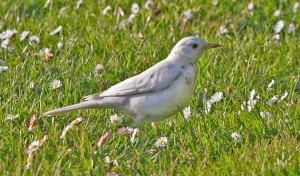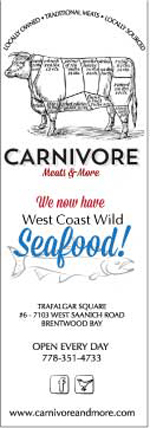Stalking the White Robin
A rare glimpse of the white robin on the Peninsula
photo and story by Ed Johnson
 Imagine my surprise when friends called me up to tell me about a white robin they had seen on the peninsula. At first they thought it must be a dove, but on closer examination it became evident that this was the rare partial albino form of the North American robin.
Imagine my surprise when friends called me up to tell me about a white robin they had seen on the peninsula. At first they thought it must be a dove, but on closer examination it became evident that this was the rare partial albino form of the North American robin.
Before heading out with a camera, a brief research was in order.
Not being a full albino which would be even rarer, the partial albino has pigment in its eyes rather than the pink colour which eventually renders the animal blind with a shorter lifespan than the usual 11 or more years. In fact, it appears, the partial albino robin is the predominate form, but both forms are only found in one in 30,000 robins. While other birds, and indeed some animals, exhibit forms of albinism, as a common yard bird, the robin is the most reported species of bird. In Native American mythology, the robin is known as the ‘can-do’ bird for its industrious nature. Its caring parental nature is considered by some as good luck for a pregnant woman to see robins feeding their young. Others saw them as a symbol of peace.
Birds lacking pigmentation are becoming a more usual sight on Vancouver Island. Well known Nanoose photographer, Mike Yip, has photographed white ravens in Qualicum over the past six years. These blue eyed birds are also partial albinos or more correctly described as leucistic, a reduction of all types of pigmentation rather than just melanin.
And now we have our own local celebrity. Knowing that robins prefer earthworms – I had fed a mother robin and her brood one spring by placing a pile of worms on a dirt pile and watching her snatch them up and fly off to her nest – I knew a bit about habitat and where to look for this particular robin. But, of course, the first time out is never lucky and all I found in the area were the normal red breasted variety.
Considering it to be a warm day and not conducive to mid day worm gathering, I decided that near evening would be both cooler and perhaps more of a stimulant to the appetite.
That hunch proved prescient. As I approached the area where this bird is usually seen, I immediately spotted her on the lawn. The picture here is my effort to get as close as possible with a 180mm lens before she took flight. Maybe I will pack a few worms next time!











